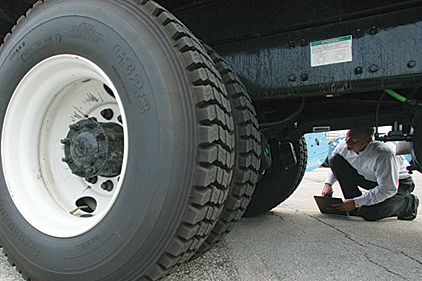Top tire tips
Steps for controlling tire costs

Tires, by a wide margin, are the top maintenance cost for most beverage fleets. Containing these costs requires frequent, thorough inspections and diligently maintaining proper tire pressure to prevent a tire’s early demise.

|
According to Goodyear Commercial Tire, paying attention to tires in 10 key areas can add thousands of dollars annually to a fleet operator’s bottom line. The following basic procedures will lower per-mile tire costs by enabling extended tread life, fewer early removals and better retreadability.
1. Keep good tire records.
Fleet operators should record detailed tire information including inflation pressures, wear trends and tire mileage at removal.
2. Determine proper inflation levels.
The biggest influence on tire life is inflation pressure. At normal speeds, running tires 20 percent below the recommended pressure will reduce tire mileage by 16 percent and fuel mileage by 2 percent. Tires are designed to run at specific pressures based on the total load. In general, pressures need to be higher if the truck is operated at a higher speed.
3. Establish a good inflation maintenance program.
Tire pressure is difficult to maintain because tires naturally lose air over time. Leakage can occur through valve caps or small punctures. To stay on top of “normal” leakage as well as any rapid leaks, tires should be checked once a week using a calibrated air gauge. Changes in ambient temperature also will affect tire pressures.
4. Keep vehicles properly aligned.
Irregular tire wear typically is caused by poor wheel alignment.
According to Goodyear, starting a serious alignment program after having none can increase tire mileage by as much as 30 percent. Drive and trailer axle positioning also can have a major effect on tire wear. Proper alignment of drive and trailer axles can extend total tire mileage by 25 percent and improve fuel mileage by 0.5 to 1 mpg.
5. Mount tires correctly.
The rounder or more concentric the tire, the better it will wear. To keep run-out to a minimum, tires always should be correctly mounted on the wheel. Ideally, tires should be match-mounted to the wheel. Wheels usually are marked to show their low spots, and tires are marked to show their high spots. Check with the wheel and tire manufacturers to see how they mark their products. The idea is to take the high spot of the tire and match it to the low spot of the wheel.
6. Learn to “read” tires.
Regular inspections can provide a lot of useful information and catch tire wear trends before they have done too much damage. Problems can be diagnosed early by visual inspection or by running a hand over the tread and feeling for abnormalities. Items to check include distortion in the tread, feathering or cupping. If corrected early enough, bad wear patterns can be countered and tire life can be extended.
7. Rotate tires.
Proper tire rotation promotes even tread-wear and can add extra miles in tread life. Some fleets will run new steer tires in the drive position to take off 1/32- to 2/32-inch in tread depth to establish a good wear pattern. Drive tires should be rotated between forward and back positions at least once to even out wear. Some drive tires also will develop heel and toe wear. This can be evened out by reversing their direction of rotation.
8. Replace tires in matched sets.
To maximize tread wear, tires should be as alike as possible across the same positions. On duals, the outside diameters and tread depths should be as close as possible. A good rule of thumb is to have no more than 2/32 inches of tread depth difference between duals. It also is wise to have the same tread design on all positions of an axle.
9. Check and replace worn components.
A wheel bearing that is not properly tightened can cause irregular tire wear. Worn shock absorbers can create depression wear on treads. To prevent irregular tire wear, shock absorbers and other suspension components should be replaced on a set schedule.
10. Reduce top speed.
High speed generates more heat and accelerates tire wear. Increasing highway speeds from 55 to 75 mph can reduce total tread mileage by 20 percent or more. So, a tire that would have provided 250,000 miles in tread life at 55 mph will net only 200,000 miles per tread if driven at 75 mph.
Looking for a reprint of this article?
From high-res PDFs to custom plaques, order your copy today!




